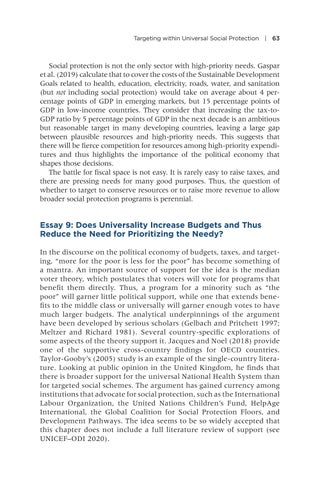Targeting within Universal Social Protection | 63
Social protection is not the only sector with high-priority needs. Gaspar et al. (2019) calculate that to cover the costs of the Sustainable Development Goals related to health, education, electricity, roads, water, and sanitation (but not including social protection) would take on average about 4 percentage points of GDP in emerging markets, but 15 percentage points of GDP in low-income countries. They consider that increasing the tax-toGDP ratio by 5 percentage points of GDP in the next decade is an ambitious but reasonable target in many developing countries, leaving a large gap between plausible resources and high-priority needs. This suggests that there will be fierce competition for resources among high-priority expenditures and thus highlights the importance of the political economy that shapes those decisions. The battle for fiscal space is not easy. It is rarely easy to raise taxes, and there are pressing needs for many good purposes. Thus, the question of whether to target to conserve resources or to raise more revenue to allow broader social protection programs is perennial.
Essay 9: Does Universality Increase Budgets and Thus Reduce the Need for Prioritizing the Needy? In the discourse on the political economy of budgets, taxes, and targeting, “more for the poor is less for the poor” has become something of a mantra. An important source of support for the idea is the median voter theory, which postulates that voters will vote for programs that benefit them directly. Thus, a program for a minority such as “the poor” will garner little political support, while one that extends benefits to the middle class or universally will garner enough votes to have much larger budgets. The analytical underpinnings of the argument have been developed by serious scholars (Gelbach and Pritchett 1997; Meltzer and Richard 1981). Several country-specific explorations of some aspects of the theory support it. Jacques and Noel (2018) provide one of the supportive cross-country findings for OECD countries. Taylor-Gooby’s (2005) study is an example of the single-country literature. Looking at public opinion in the United Kingdom, he finds that there is broader support for the universal National Health System than for targeted social schemes. The argument has gained currency among institutions that advocate for social protection, such as the International Labour Organization, the United Nations Children’s Fund, HelpAge International, the Global Coalition for Social Protection Floors, and Development Pathways. The idea seems to be so widely accepted that this chapter does not include a full literature review of support (see UNICEF–ODI 2020).


